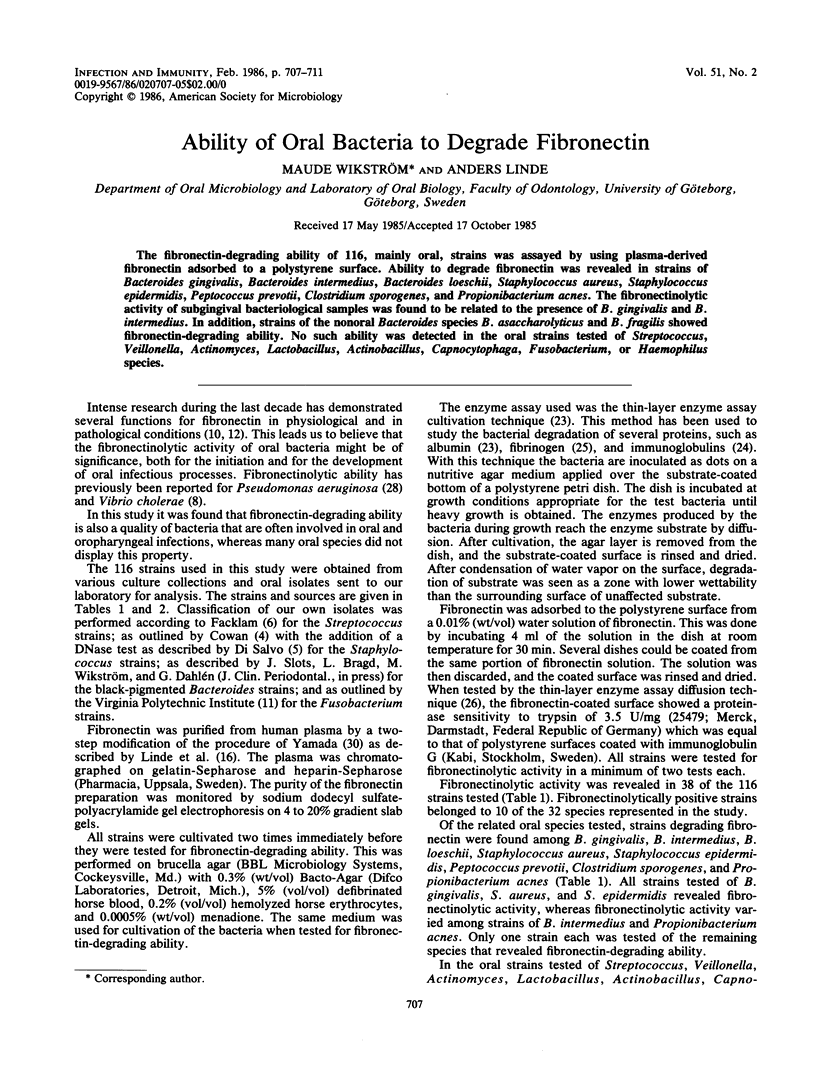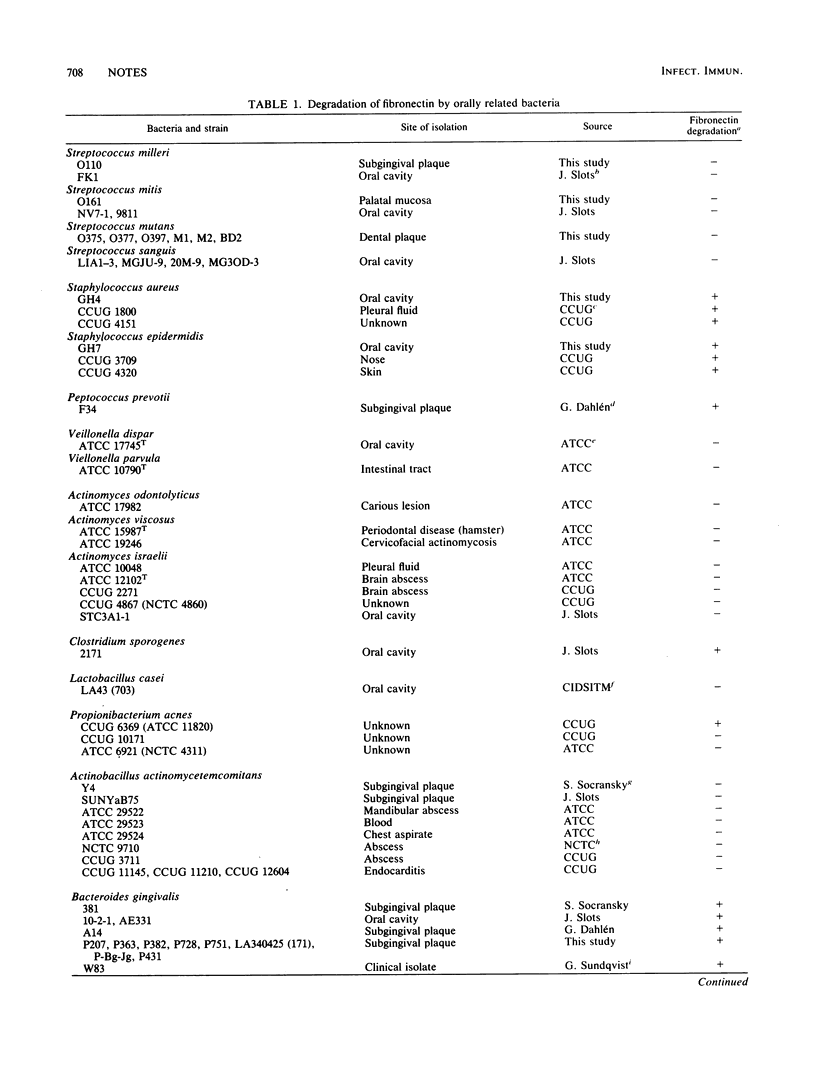Abstract
The fibronectin-degrading ability of 116, mainly oral, strains was assayed by using plasma-derived fibronectin adsorbed to a polystyrene surface. Ability to degrade fibronectin was revealed in strains of Bacteroides gingivalis, Bacteroides intermedius, Bacteroides loeschii, Staphylococcus aureus, Staphylococcus epidermidis, Peptococcus prevotii, Clostridium sporogenes, and Propionibacterium acnes. The fibronectinolytic activity of subgingival bacteriological samples was found to be related to the presence of B. gingivalis and B. intermedius. In addition, strains of the nonoral Bacteroides species B. asaccharolyticus and B. fragilis showed fibronectin-degrading ability. No such ability was detected in the oral strains tested of Streptococcus, Veillonella, Actinomyces, Lactobacillus, Actinobacillus, Capnocytophaga, Fusobacterium, or Haemophilus species.
Full text
PDF




Selected References
These references are in PubMed. This may not be the complete list of references from this article.
- Abraham S. N., Beachey E. H., Simpson W. A. Adherence of streptococcus pyogenes, Escherichia coli, and Pseudomonas aeruginosa to fibronectin-coated and uncoated epithelial cells. Infect Immun. 1983 Sep;41(3):1261–1268. doi: 10.1128/iai.41.3.1261-1268.1983. [DOI] [PMC free article] [PubMed] [Google Scholar]
- Babu J. P., Simpson W. A., Courtney H. S., Beachey E. H. Interaction of human plasma fibronectin with cariogenic and non-cariogenic oral streptococci. Infect Immun. 1983 Jul;41(1):162–168. doi: 10.1128/iai.41.1.162-168.1983. [DOI] [PMC free article] [PubMed] [Google Scholar]
- Carlsson J., Herrmann B. F., Höfling J. F., Sundqvist G. K. Degradation of the human proteinase inhibitors alpha-1-antitrypsin and alpha-2-macroglobulin by Bacteroides gingivalis. Infect Immun. 1984 Feb;43(2):644–648. doi: 10.1128/iai.43.2.644-648.1984. [DOI] [PMC free article] [PubMed] [Google Scholar]
- Facklam R. R. Physiological differentiation of viridans streptococci. J Clin Microbiol. 1977 Feb;5(2):184–201. doi: 10.1128/jcm.5.2.184-201.1977. [DOI] [PMC free article] [PubMed] [Google Scholar]
- Finkelstein R. A., Boesman-Finkelstein M., Holt P. Vibrio cholerae hemagglutinin/lectin/protease hydrolyzes fibronectin and ovomucin: F.M. Burnet revisited. Proc Natl Acad Sci U S A. 1983 Feb;80(4):1092–1095. doi: 10.1073/pnas.80.4.1092. [DOI] [PMC free article] [PubMed] [Google Scholar]
- Gadasi H., Kessler E. Correlation of virulence and collagenolytic activity in Entamoeba histolytica. Infect Immun. 1983 Feb;39(2):528–531. doi: 10.1128/iai.39.2.528-531.1983. [DOI] [PMC free article] [PubMed] [Google Scholar]
- Hynes R. O., Yamada K. M. Fibronectins: multifunctional modular glycoproteins. J Cell Biol. 1982 Nov;95(2 Pt 1):369–377. doi: 10.1083/jcb.95.2.369. [DOI] [PMC free article] [PubMed] [Google Scholar]
- Kilian M. Degradation of immunoglobulins A2, A2, and G by suspected principal periodontal pathogens. Infect Immun. 1981 Dec;34(3):757–765. doi: 10.1128/iai.34.3.757-765.1981. [DOI] [PMC free article] [PubMed] [Google Scholar]
- Kilian M., Thomsen B., Petersen T. E., Bleeg H. S. Occurrence and nature of bacterial IgA proteases. Ann N Y Acad Sci. 1983 Jun 30;409:612–624. doi: 10.1111/j.1749-6632.1983.tb26903.x. [DOI] [PubMed] [Google Scholar]
- Laughon B. E., Syed S. A., Loesche W. J. API ZYM system for identification of Bacteroides spp., Capnocytophaga spp., and spirochetes of oral origin. J Clin Microbiol. 1982 Jan;15(1):97–102. doi: 10.1128/jcm.15.1.97-102.1982. [DOI] [PMC free article] [PubMed] [Google Scholar]
- Linde A., Berghem L. E., Hansson H. A., Jonsson R., Redfors Y. Ultrastructural localization of fibronectin in duct cells of human minor salivary glands and its immunochemical detection in minor salivary gland secretion. Arch Oral Biol. 1984;29(11):921–925. doi: 10.1016/0003-9969(84)90092-x. [DOI] [PubMed] [Google Scholar]
- Myhre E. B., Kuusela P. Binding of human fibronectin to group A, C, and G streptococci. Infect Immun. 1983 Apr;40(1):29–34. doi: 10.1128/iai.40.1.29-34.1983. [DOI] [PMC free article] [PubMed] [Google Scholar]
- Simpson W. A., Beachey E. H. Adherence of group A streptococci to fibronectin on oral epithelial cells. Infect Immun. 1983 Jan;39(1):275–279. doi: 10.1128/iai.39.1.275-279.1983. [DOI] [PMC free article] [PubMed] [Google Scholar]
- Slots J. Enzymatic characterization of some oral and nonoral gram-negative bacteria with the API ZYM system. J Clin Microbiol. 1981 Sep;14(3):288–294. doi: 10.1128/jcm.14.3.288-294.1981. [DOI] [PMC free article] [PubMed] [Google Scholar]
- Werner H., Müller H. E. Immunelektrophoretische Untersuchungen über die Einwirkung von Bacteroides-, Fusobacterium-, Leptotrichia- und Sphaerophorus-Arten auf menschliche Plasmaproteine. Zentralbl Bakteriol Orig. 1971;216(1):96–113. [PubMed] [Google Scholar]
- Wikström M. B., Dahlén G., Kaijser B., Nygren H. Degradation of human immunoglobulins by proteases from Streptococcus pneumoniae obtained from various human sources. Infect Immun. 1984 Apr;44(1):33–37. doi: 10.1128/iai.44.1.33-37.1984. [DOI] [PMC free article] [PubMed] [Google Scholar]
- Wikström M. B., Dahlén G., Linde A. Fibrinogenolytic and fibrinolytic activity in oral microorganisms. J Clin Microbiol. 1983 May;17(5):759–767. doi: 10.1128/jcm.17.5.759-767.1983. [DOI] [PMC free article] [PubMed] [Google Scholar]
- Wikström M. B. Detection of microbial proteolytic activity by a cultivation plate assay in which different proteins adsorbed to a hydrophobic surface are used as substrates. Appl Environ Microbiol. 1983 Feb;45(2):393–400. doi: 10.1128/aem.45.2.393-400.1983. [DOI] [PMC free article] [PubMed] [Google Scholar]
- Wikström M., Elwing H., Linde A. Determination of proteolytic activity: a sensitive and simple assay utilizing substrate adsorbed to a plastic surface and radial diffusion in gel. Anal Biochem. 1981 Dec;118(2):240–246. doi: 10.1016/0003-2697(81)90185-8. [DOI] [PubMed] [Google Scholar]
- Woods D. E., Bass J. A., Johanson W. G., Jr, Straus D. C. Role of adherence in the pathogenesis of Pseudomonas aeruginosa lung infection in cystic fibrosis patients. Infect Immun. 1980 Dec;30(3):694–699. doi: 10.1128/iai.30.3.694-699.1980. [DOI] [PMC free article] [PubMed] [Google Scholar]
- Woods D. E., Straus D. C., Johanson W. G., Jr, Bass J. A. Role of fibronectin in the prevention of adherence of Pseudomonas aeruginosa to buccal cells. J Infect Dis. 1981 Jun;143(6):784–790. doi: 10.1093/infdis/143.6.784. [DOI] [PubMed] [Google Scholar]
- Woods D. E., Straus D. C., Johanson W. G., Jr, Bass J. A. Role of salivary protease activity in adherence of gram-negative bacilli to mammalian buccal epithelial cells in vivo. J Clin Invest. 1981 Dec;68(6):1435–1440. doi: 10.1172/JCI110395. [DOI] [PMC free article] [PubMed] [Google Scholar]


